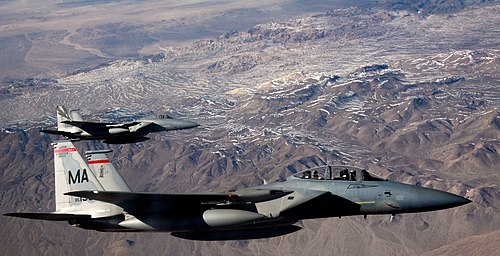The 131st Fighter Squadron
The 131st Fighter Squadron is a unit of the Massachusetts Air National Guard 104th Fighter Wing located at Barnes Air National Guard Base, Westfield, Massachusetts. The squadron is equipped with the F-15C/D Eagle.
History
World War II
The squadron was first established in August 1942 at Bellows Field, Hawaii Territory as the 333d Fighter Squadron. It initially focused on the air defense of Hawaii, operating P-39 Airacobras. The squadron also served as a Replacement Training Unit (RTU) and conducted reconnaissance patrols over Hawaii until late 1943.
In late 1943, the 333d deployed to the Central Pacific as part of the Thirteenth Air Force island hopping campaign against Japanese forces. The squadron engaged in combat until April 1944, when it returned to Hawaii to re-equip and train with long-range P-51 Mustangs. The squadron redeployed to the Western Pacific and was stationed on Iwo Jima, engaging in long-range B-29 Superfortress escort missions over Japan until the end of hostilities in August 1945. The unit was later reassigned to the Mariana Islands and was inactivated in 1946.
Massachusetts Air National Guard
After the war, the 333d Fighter Squadron was redesignated as the 131st Fighter Squadron and allocated to the Massachusetts Air National Guard on 24 May 1946. It was organized at Barnes Municipal Airport, Westfield, Massachusetts, and received federal recognition on 24 February 1947, initially equipped with P-47D Thunderbolts as part of the 102d Fighter Group.
Air Defense Mission
The mission of the 131st Fighter Squadron was to provide the air defense of Massachusetts. Following the surprise invasion of South Korea in June 1950, most of the Air National Guard was federalized, but the 131st remained under the Commonwealth of Massachusetts to fulfill its air defense mission. In 1951, the squadron transitioned to the F-51H Mustang and was redesignated as the 131st Fighter-Interceptor Squadron. It placed aircraft on air defense “runway alert” for the first time in 1953.
In 1954, as the P-51H aircraft reached the end of their lifespan, the squadron transitioned to the F-94A Starfire interceptors.
Tactical Air Command
On 10 November 1958, the 131st’s air defense mission concluded as it was reassigned to Tactical Air Command (TAC) and converted to F-86H Sabre fighter-bombers. During the early 1960s, the squadron’s readiness improved significantly.
1961 Berlin Federalization
In response to the 1961 Berlin Crisis, the 131st Tactical Fighter Squadron was federalized on 1 October and assigned to the 102d Tactical Fighter Wing. The squadron operated within NATO forces, providing close air support in various exercises in Europe.
Vietnam Era
After the Berlin Crisis, the 131st improved its readiness under the regular Air Force’s Tactical Air Command. Transitioning to the F-84F Thunderstreak in 1964, the squadron supported numerous missions but was not activated during the Vietnam War despite several pilots volunteering for duty.
Close Air Support
In July 1979, the 131st upgraded to the A-10 Thunderbolt II, marking a significant change as the Air Guard became an integrated part of daily Air Force operations. The squadron began frequent deployments to NATO bases.
During the Gulf Crisis, the 131st was slated to receive the F-16, but due to operational failures, the squadron continued its mission with the A-10.
Air Combat Command
In March 1992, the unit was redesignated as the 131st Fighter Squadron as TAC transitioned to Air Combat Command (ACC). In 1995, the squadron deployed to Italy as part of NATO operations during the Bosnian conflict. This deployment marked the first combat sorties for the squadron since World War II.
In 2003, during the Global War on Terrorism, the 131st Expeditionary Fighter Squadron conducted numerous missions in support of Operation Enduring Freedom and Operation Iraqi Freedom.
BRAC 2005
In its 2005 BRAC Recommendations, the Department of Defense recommended that the 131st transition from A-10s to the F-15s, marking the end of its close air support mission. By the end of 2007, the 131st had fully integrated F-15Cs and established a homeland security mission.
Lineage
- Constituted as the 333d Fighter Squadron (Single Engine) on 18 August 1942
- Activated on 23 August 1942
- Inactivated on 12 January 1946
- Redesignated 131st Fighter Squadron, Single Engine on 24 May 1946
- Extended federal recognition on 24 February 1947
- Redesignated 131st Fighter-Interceptor Squadron on 16 August 1952
- Redesignated 131st Tactical Fighter Squadron on 10 November 1958
- Federalized on 1 October 1961
- Returned to Massachusetts control on 31 August 1962
- Redesignated 131st Tactical Fighter Squadron on 15 October 1962
- Redesignated 131st Fighter Squadron on 1 June 1992
Assignments
- 18th Fighter Group, 23 August 1942
- 318th Fighter Group, 11 January 1943 – 12 January 1946
- 102d Fighter Group (later 102d Fighter-Interceptor Group), 24 February 1947
- 104th Fighter Group (Air Defense) (later 104th Tactical Fighter Group), 1 May 1956
- 102d Tactical Fighter Wing, 1 October 1961
- 104th Tactical Fighter Group (later 104th Fighter Group), 20 August 1962
- 104th Operations Group, Oct 1995–present
Stations
Details regarding Massachusetts Air National Guard deployments and aircraft specifics can be found in dedicated military archives.

